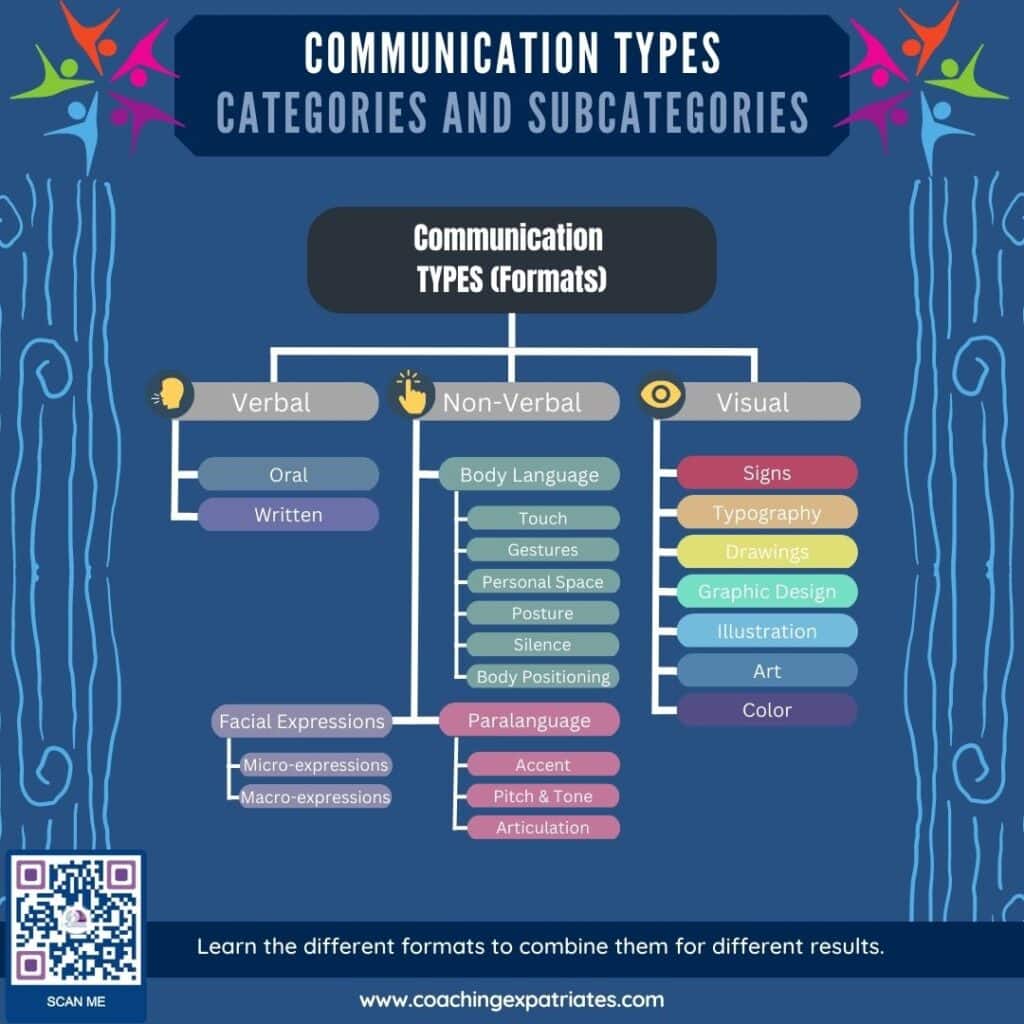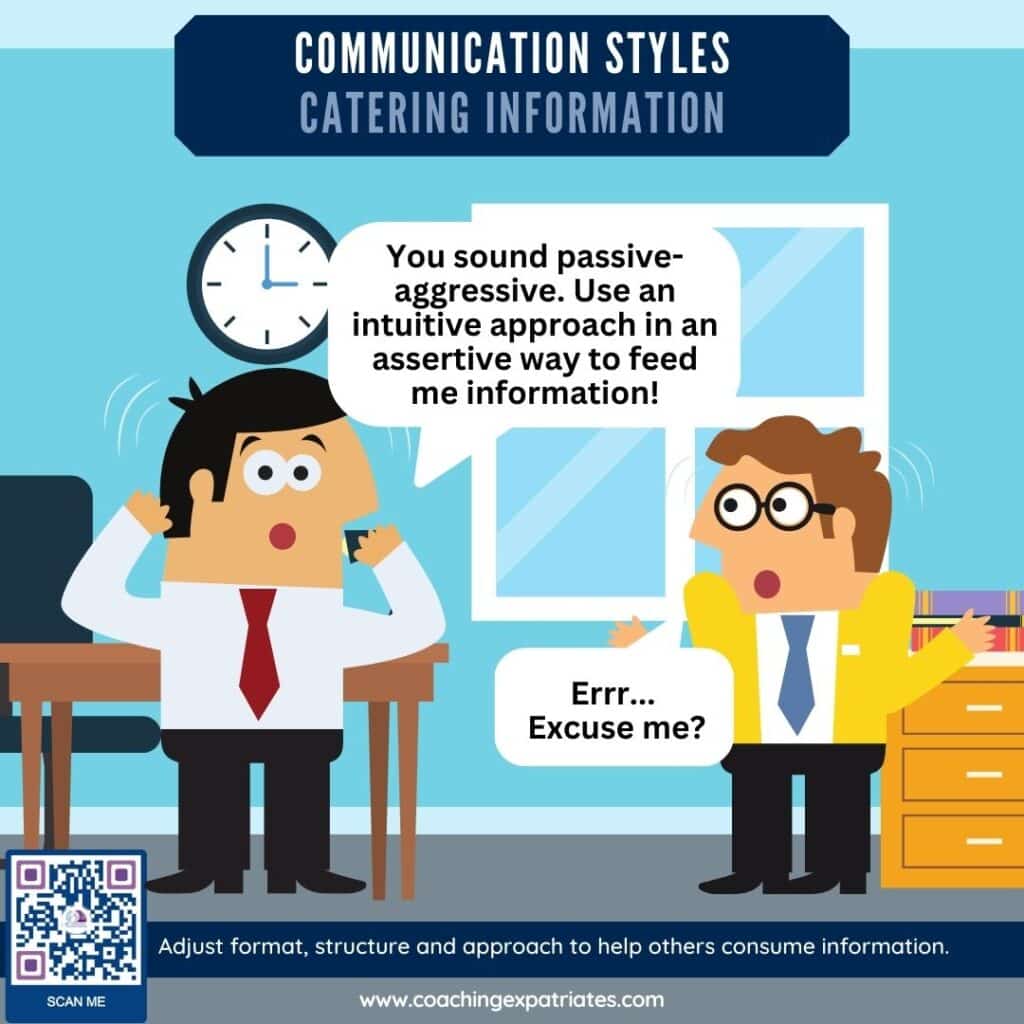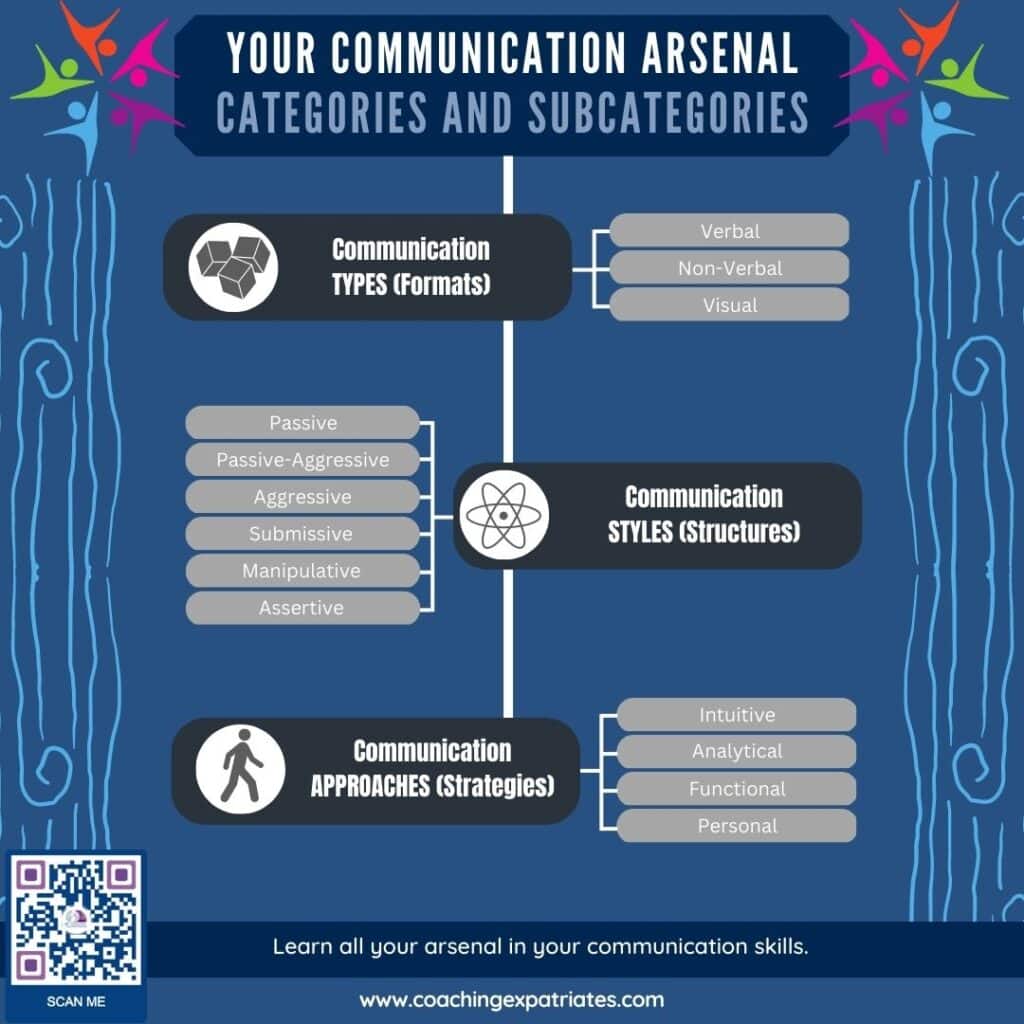BUSY LIFE AND NEED MORE THAN THIS POST?
Download The Full Communication Guide To Read Later
Knowing communication styles, skills, and how to use them effectively can be a considerable tool in achieving your goals and moving ideas forward as a global leader. Today, we will talk about the 6 main communication styles and why knowing them matters, how they can be applied smartly in different formats, how non-verbal communication can play into these styles, how to address different decision-makers when communicating, and, finally, our 2 cents on how to become a better communicator.
The overarching communication skills are a heavy-weight aspect of successful People Leadership, one of the 4 Success Pillars. If your work has an international reach, you feel more than anyone the weight communication has on achieving goals and driving ideas. That’s why we included here a dedicated section to tell you all the benefits you’ll gain from learning the entire content of this article, before jumping into the concepts.
Why Knowing The 6 Communication Styles Matter
Humankind is known for its complex structure of communication. We are the only species that developed advanced forms of communication, including written communication and signs. So, there is no escaping from communicating to achieve something in our society: we all need to communicate to survive.
Now, let’s face it: survival is an ample reason why learning about communication styles is important and how to navigate them. So how about we drill this down a little further, and understand why this is critical for you, the global leader?
There are some concrete reasons why you should consider understanding communication styles and learning them for your advantage when expressing your ideas in global settings. Let’s learn them:
Because It Builds The Right Connections
Communication is necessary to express ideas, but using specific styles depending on the right occasions has the power to build meaningful connections. As we mentioned in a previous post, each interaction counts when building reputation and trust, so learning the right way to address people can be the difference between staying as an acquaintance or making a fruitful connection.
Because It Ensures Career Success
Raise their hands who have over 2 career decades under their belts and never heard the “you have to improve your communication” feedback. Needing to learn how to communicate better and express ideas effectively will always happen at some point in our careers. The sooner, the better. Studies show that communication skills has a tremendous impact on career success.
Because It Strengthens Physical and Mental Health
It might sound bizarre, but studies show that being a good communicator and leveraging communication styles effectively can positively impact both physical and mental health.
- On the physical level, this has to do with the fact that communicating things well will address your immediate physical needs and requirements.
- On the mental health aspect, this has to do with the fact that it helps you improve your confidence, fulfillment, and self-reliability.
I totally relate to this and even have an example to share. When I came to the US as an expatriate, my bank account denied me a credit card twice in a row. It was very frustrating for me since they were an institution that had previously worked with me in many other countries. They knew me, my background, and my ethics inside out. Other institutions in the US, who knew me much less, had already approved a credit card for me, but my own bank did not. So, I decided to change my communication style, approach, and medium. I sent them a physical letter, very well-written, structured, and using an assertive communication style. Not only they accepted me, but they gave me double the credit limit that I had on any other card. The result of this effort made me feel super confident in my skills and very fulfilled. You probably have your own stories as well. Being a good communicator and knowing how to navigate the different communication styles can be powerful both for mental and physical health.
Because It Lowers Depression Rates
Very much in line with the previous topic, knowing how to navigate communication styles and approaches has been shown to lower rates of depression. This has to do with the cognitive processing of information, fears, and dreams. If you learn how to better communicate with yourself, your medical care team, and others around you, the chances of avoiding a depression before it happens or reversing clinical depression that is present are higher. If you’ve ever been depressed, you know how it feels. The sense of hopelessness seems to engulf you, and even expressing what you think, seems pointless. But those who were shown to communicate their cognitive processes better, especially with their medical providers, have had better chances of getting better and keeping out of the inpatient lists.
Because It Helps In Solving Conflicts
This is a big one, and reason enough to understand and master communication styles and their different approaches: solving conflicts. Wherever we go, there will always exist a conflict. Conflicts exist because 2 individuals have different ideas and/or values about something, which will make them want different things. And that’s what a conflict stems from. Resolution of conflict is like problem-solving. It can be challenging and overwhelming. But there is always a solution. A solution does not mean all needs will be met, but sometimes it does.
I will never forget my first negotiation training. Our class was given a study case, and we had to negotiate around it. Each “group” was tasked with different things, so we had to “negotiate” a conflict. All 3 groups had to purchase a number of oranges from a 4th group, the supplier, who had 1,000 oranges. The 3 buyers had to reach an agreement about quantity and price. Clearly, there were not enough oranges for all, and the supplier held all the bargaining power. Believe it or not, we were able to find a way to negotiate a deal where all 4 groups got what they needed, for the best deal.
This experience had a powerful learning effect for me. And my takeaway is: communication skills help you address what is needed beyond the want. Most of the time, people tell you what they want, not what they really need. Sometimes, they don’t have full awareness of what their needs really are. But you can collect the right information by using good communication skills and the right communication styles. And that’s how many conflicts are solved. If you want to learn more about how we accomplished this orange study case, subscribe to my newsletter and write to me! Or you can book a Free Strategy Call with me, and we can discuss an event for your corporation to help your team learn from this Study Case as well.
Because It Shows Empathy
I know this does not sound reason enough to many, but if you are my reader here, I hope you can understand why I include this here. Our world is not a transactional world like it used to be. It’s moving more and more from a transactional world to a relational world. What this means is that whenever you want something, you don’t get it with simple transactions anymore. We need connections and relationships.
Do you want a job? Do you want to close a deal? Do you want a scholarship? Do you want more credit limits? Nothing we want is a transaction anymore. That’s why social media is so prominent nowadays. Nobody cares about the transaction anymore. We care about how people, institutions, companies, and governing bodies make us feel.
If we don’t have empathy, we will fail to connect correctly and build a lasting relationship. It’s said that people only want to do business with those who they know, like, and trust. This happens now, not only for businesses. It’s reflected in everything else. Today, we are out of the game if we don’t connect, relate, and demonstrate empathy as professionals and corporations.
Because It Asserts Influence
If you read Cialdini and any of the great Influence masterminds, you know this: asserting influence requires an undeniable level of expertise in communication and communication styles. Any of the 6 principles of influence can be used if you don’t have the bare minimum knowledge of communication skills and how to use them for influence.
Because It Helps Fast-Track Decision-Making
There are many things required to speed up decision-making for individuals or groups, but none of them are possible if you don’t have a good understanding of communication styles, communication approaches, and techniques for contextual communication. If you know all about the 6 decision-maker styles and how to address each, but fail to correctly address them because your communication style is faulty, then your previous knowledge is useless.
What’s The Difference Between Communication Styles, Communication Types, And Communication Approaches?
If you ever considered this question, good job, because THAT is an excellent question! I hope you realized already how the internet is flooded with “guides” that make no distinction between these things. However, these skills are different and used for different purposes.
Many people confuse types, styles, and approaches when it comes to communication skills. So before we move on, I’d like to outline the key distinctions between each and how they are frequently used.
- Communication types are what forms of communication will be used to address interactions. Bottom line: it’s the format.
- Communication styles are how that communication will flow and be executed. Bottom line: it’s the structure.
- Communication approaches are the strategies you will use to express an idea, using a specific format and flow. Bottom line: it’s the strategy.
What Are the Communication Types We Have At Our Disposal?
There have 3 main forms of communication types:
Verbal Communication
Verbal communication is made of oral communication and written communication. Although some individuals use verbal communication interchangeably with oral communication, that is a wrong classification. Both Oral and Written communications are part of verbal communication, which means communicating through words, phrases, and languages to express an idea.
Non-Verbal Communication
Non-verbal communication is made up of body language, paralanguage, and facial expressions. It’s the most difficult aspect of communication, where many individuals fail to use and understand correctly.
- Body language: Touch, gestures, personal space, posture, silence, body positioning.
- Paralanguage: accent, pitch and tone of voice, articulation.
- Facial expressions: micro-expressions and macro expressions.
Visual Communication
Visual communication is made of signs, typography, drawings, graphic design, illustrations, art, and color
Quick Application Exercise
Let’s do an exercise together so you can understand the power of this knowledge. Imagine someone you love. Ready? Now think how you would express “I love you!” to this person using each of these types or formats. How would you use verbal communication? Maybe a love letter? Maybe you will create a love song and sing it? Maybe you’ll just bark, “I love you,” and get it over with. And how would you use non-verbal communication? Would you make a heart shape with your hands and then hug them? And how about visual communication? Would you draw or paint a portrait to express your love?
Each type or form of communication is a different venue for expression.

What Are The 6 Communication Styles
Now that you got the form out of the way and know more about it, let’s talk about styles. If types helped you decide on the format of the communication, styles help you identify the structure of your communication and, especially, its tone. There are 6 main communication styles.
Communication Style: PASSIVE
The Passive Style is associated with individuals who agree to whatever the others in the group want or are saying. Their individual opinions are kept to themselves, even when they tend not to agree. May also be doing it to come off as not caring.
Example: “Yeah, I’m sure this is the best idea. Let’s go with your idea.”
How do you know this is passive? What’s important to emphasize is that sometimes the words alone do not allow you to identify the style being used. You’ll have to take note of body language, tone of voice, and facial expressions. Also, how engaged was this person in the conversation? Did they make interjections and share their opinions? Context is important when evaluating styles. Asian cultures and cultures that value hierarchy are notably passive in their style, and unless you don’t invite them to share their opinions, they won’t. Most people using passive style are just trying to avoid conflicts, either to make the conversation flow or out of fear.
Communication Style: PASSIVE-AGGRESSIVE
The Passive-Aggressive Style relates to individuals who appear passive on the surface but are really acting out anger in a subtle, indirect, or behind-the-scenes way. They can use subtle sarcasm, attacks that sound like compliments, and other forms of hidden aggression.
Example: “Yeah, I’m sure this is the best idea. Your ideas are always the best.”
People using this style frequently are inserting messages in between the lines. In this example, the message could be that the other person is not open-minded enough to listen, so why bother? The use of sarcasm or comments that seem a compliment but are derogatory underneath is usually what can tip you off that a passive-aggressive style is being used. Again, context is important: in this same example, the person could actually be using the assertive style instead, depending on the engagement in the conversation and how they already shared their ideas. They might have concluded that this is not only the best idea, but they might be convinced that you always have the best ideas, and are just assertively sharing their thoughts. But in most cases like this one, this is not the case. The use of sarcasm is prevalent through a passive-aggressive style.
Communication Style: AGGRESSIVE
The Aggressive Style is characterized by being controlling, demanding, and even hostile. There is a use of intimidation, many interruptions, and few questions to probe perceptions. Will openly express their opinion without thinking twice, usually in a loud and dominant voice.
Example: “Your idea always sucks. There’s no way I’ll go with that. We’ll do it my way.”
People using this style might sound assertive, but what helps you see it’s aggressive is that they don’t care about what other people think. They demand and control based on what their wants and needs are. This is notably used by people with a more aggressive personality or leaders who purposefully and intentionally use this style to avoid room for debate when the situation needs it. For example, if you discuss with your employee their recurring offenses towards minorities in the workplace, you won’t select a passive style. You will probably use an aggressive style to demand what the company needs from them, or an assertive style as a minimum.
Communication Style: SUBMISSIVE
The Submissive Style is characterized by people who avoid conflicts and confrontations at all costs. They tend to submit to others’ requests, using expressions that show they feel like victims, are apologetic, and avoid taking responsibility.
Example: “I wouldn’t even think about any other idea. Let’s go with yours.”
People using the submissive style literally submits to the other person. It’s different from the passive style, because with passive, the individual might secretly have an objection and even a hidden agenda. The submissive, however, really submits to the other people in the interaction, as intimately they believe it’s the best course of action. It’s rare to see individuals use the submissive style as their first choice of interaction, although it can happen as a strategy in certain negotiations. Remember that during interactions, people can quickly move from other styles to submissive and vice-versa, depending on the other person’s style and situation.
Communication Style: MANIPULATIVE
Communicators using a Manipulative Style are skilled at doing whatever it takes to gain a personal advantage in any given situation. They manipulate others and stretch truths in order to get what they want.
Example: “How about we go with your excellent idea? You’ll be the best person, then, to tackle all this paperwork, right?”
People using this style want others to do something, and they will often use the other’s own words and ideas to twist things in such a way that they will make things go their way. Note that I used the word “manipulative” and not “influential.” The difference is that manipulation is doing what you want regardless of what others want, while influencing is helping others see value in things that will also benefit them.
Communication Style: ASSERTIVE
Communicators using the Assertive Style are able to express their honest thoughts in a polite and respectful way. They usually take other people’s thoughts and feeling into consideration, ask questions, and are straightforward in their answers.
Example: “This is a tough call, but let’s go with Sarah’s idea since it’s the fastest and most cost-effective one.”
People using assertive communication usually are straightforward about what they think and why they think so. They share, wait for a reaction, and take the interaction from there in a fearless but caring way.
Communication Styles: Your Natural Preferences
Most people have a natural preference for a style. This preference usually is formed based on personal background and knowledge, past experiences, and cultural background. People who are reserved and hate confrontation might enter interactions with a passive tone. There are people who are naturally forceful and might make use of aggressive styles more often than not. Other people might have had the privilege of being raised in environments where assertive communication was primarily used and learned from it.
What matters for you is that you identify which style people around you are using, so that you can adjust and communicate better. If you know someone is being submissive, maybe you’ll want to take a few moments to understand what’s going on beneath that conversation. If someone is being passive-aggressive, you’d want to resolve hidden feelings before moving on. If you have someone who is routinely aggressive, you might need to take some time to provide positive feedback and set some boundaries.
In your next conversation, be it casual or professional, try to identify the other person’s style. Ask yourself, “why they chose that style?” What is being said that I am not listening, and what are they not telling me that I must inquire?

Nonverbal Communication & Cues That Help Pivoting Communication Styles
As the interviewee, I once was in an interview when the interviewer suddenly sat back and crossed his arms. Most interviewers are trained to avoid blunt body language like that, so that caught me by surprise. As soon as I picked that up, I finished my phrase and said, “I noticed some reactive body language right there. Could you share with me what crossed your mind when I was saying that?” He was caught so off guard that he leaned forward, made a remark about my perceptiveness, and really shared what was on their mind, which was not in my favor. I was not able to change their mind, but because the communication lines and trust barriers opened up after that, we created a connection that continued after the interview was over. To this day, this recruiter, a top CEO of a top global company today, is one of my valued connections.
Non-verbal communication and cues are a make or break in communication. You can only take advantage of it if you learn about non-verbal communication and if you make a self-commitment to pay attention to it. As I mentioned in my Communicating With High And Low Context Culture post, some cultures are naturals in observing non-verbal communication and extracting meaning from it, while others do not so much. People raised in Low Context Communication cultures tend to pay less attention to it. This way, people in Germany and Finland will pay much less attention to body language than those in Brazil and Mexico. The Culture Map is an ingenious way to understand who you are interacting with and how to pay better attention to non-verbal communication. It basically helps you put yourself on a cultural scale and compare to others based on their cultural background. Then you address their needs based on which side of the scale they are in relation to you. Quite brilliant!
The main takeaway I want you to take from this section is that non-verbal communication has a much bigger weight than we think. Albert Mehrabian, an Armenian born in 1939, was famous for studying the importance of verbal versus nonverbal communication. His findings were later lead to the creation of the 7-38-55 rule. This rule postulates that we deduce a person’s feelings and thoughts based 7% on what they say – or spoken communication – 38% on people’s voice modulation or tone of voice, and 55% on body language – or non-verbal communication. This means that more than half of what you are saying is picked up by what you are NOT saying. How crazy is that?
Using The Right Communication Style For Different Decision-Maker Types
If you’re still with me, you learned how types affect format and styles affect structure. Now, let’s address strategy. In this section, I’d like to address 2 different things: the 4 different communication approaches, or how communicators approach and perceive things, and how communicators navigate different audiences to deliver their messages.
The 4 Communication Approaches:
Intuitive Communicators:
Intuitive communicators are unemotional and freeform when consuming information. They want to see the big picture and broad overview first before drilling down.
How to influence them: provide a good overview, with a straight-to-the-point executive summary, and explain why the topic is important.
How to drive them crazy: start throwing too many details and statistics at them.
Analytical Communicators:
Analytical communicators are unemotional and linear when consuming information. They want precise communications that convey data and information, including hard facts and numbers.
How to influence them: show evidence, facts and numbers first.
How to drive them crazy: talk around the point or bring different points of view.
Functional Communicators:
Functional communicators are emotional and linear when consuming information. They like to have control of the process, structure, and well-thought-out plans.
How to influence them: give them process-oriented information with step-by-step details of the plan. The more structure, the better.
How to drive them crazy: not showing up with a structured plan or saying they’ll need to swing it.
Personal Communicators:
Personal communicators are emotional and freeform when consuming information. They want to establish an interpersonal relationship, and understand what’s on your head.
How to influence them: use emotional language in an informal, friendly, and warm way, while getting them involved in talking about it, and how they think your initiative will impact others they care and themselves.
How to drive them crazy: throw at them an executive summary without ever mentioning the impact on people or how those ideas came to be.

Catering Communication To Different Decision-makers
Now that you learned how most people approach communication, it’s time to talk about how to expand it and drill down into this concept so that you can communicate an idea and help other people decide faster.
In the same way people use different approaches to communicate and consume information, they also use different approaches to make decisions. As you know, decision-making is a science, and it consists of a 7-step process. These 7 steps can happen faster or slower. A decision is made and implemented once the individuals or group of people go through the entire 7 step process of decision-making.
Anyone who understands these 7 steps and how to expedite them can shorten the time it takes to go through them, and make a decision happen faster. And you can do this by understanding the 6 different decision-makers styles and what they value. Cater the correct information, using the right approach to each decision-maker, and boom; decisions will happen faster. We have an entire post on this topic, and I highly recommend reading it and taking the quiz to find out your decision-maker style.
How Does Direct Versus Indirect Communication Fit The Communication Styles?
If you paid close attention to the styles, you noticed that they could be divided into 2 main groups.
Direct Communication Styles:
Direct communication is when the speaker communicates their thoughts and feelings directly to the listener. They may be candid and open, and they may not filter their thoughts. Direct styles are the assertive and aggressive styles.
Indirect Communication Styles:
Indirect communication is when the speaker communicates their thoughts and feelings indirectly. They may communicate through others, or they may withhold information. Indirect styles are the passive, passive-aggressive, manipulative, and submissive styles.
Direct communication is often more effective because it is more upfront and honest. However, indirect communication can be more persuasive, depending on the context, because it is less hurtful and confrontational. That’s the whole point about understanding the styles: how and when to use it is an art, depending on the context, what you want to achieve, and the audience in front of you.
Using The Right Communication Style For Different Decision-Maker Types
Now let’s talk about the reason why you clicked this link in the first place: you want to know how to become a better communicator and improve your global leadership using the communication styles and all the other background information you got here. So here is how:
Becoming A More Assertive Communicator
I would love to say that you can get away with not being assertive with some cultures, but I learned that this is not correct. Being assertive is very beneficial in any culture if you adjust the right types (format), approaches (strategies), and decision-making styles (audience) in your communication. So, yeah, be assertive whenever you can.
Don’t sugarcoat things or soften them. Say “will” instead of “could” or “should“. Think of how different these two sentences sound: “I will take the lead on this project.” vs. “I could take the lead on this project.” On a level of 1 to 10, being 10 super confident, how each of these phrases sounds in terms of confidence?
Being assertive to express your transparency, ethics, and confidence is part of your job description. If this style is not your main natural preference, don’t panic! Practice, so it becomes more natural to you.
"Communication is the real work of leadership."
Nitin Nohria Tweet
Using Communication Styles, Types, And Approaches Smartly
In this article, you learned the different types, styles, and approaches involved in communication. Now, it’s a matter of putting them into practice and learning from your experiences. The more you use them, the more you’ll perfect them. Here you got some examples of use, but if you are still doubtful about how to use them in your own circumstances or situations, maybe you’ll see tons of value in hiring a professional coach that could help you with your challenges.
"Communication – the human connection – is the key to personal and career success."
Paul J. Meyer Tweet
Using Cultural Context Communication
Learning cultural context communication is vital to know what and how to address things depending on cultural background. Today, diversity is a buzzword, right? Cultural background is just one dimension of diversity. You cannot appreciate and deal effectively with diversity if you have not learned cultural context communication. This can be a secret weapon in your communication arsenal. We have an entire guide on this topic, in case you didn’t read it yet.
"Leadership is a way of thinking, a way of acting and, most importantly, a way of communicating."
Simon Sinek Tweet
Listening To Understand, Not To Reply
We will all be super skinny if one fat cell evaporates from our bodies whenever someone says how important listening to other people is. I know that, and sometimes I am troubled practicing it. Ask my husband. The most challenging communication problem that exists is that we do not listen to understand. We listen to reply. How often are we so excited about our opinion or an idea that we interrupt people, especially communicators who are using a submissive or passive style? We must be super watchful, especially if we tend to jump the gun, and we must carefully listen to those around us. Then, whenever possible, we must use advanced listening skills, inviting others to give their opinions and hear them out until the end, even if it doesn’t sound all that interesting.
"The biggest communication problem is we do not listen to understand. We listen to reply."
Stephen Covey Tweet
Managing Expectations
Whoever is subscribed to my newsletter knows how important I think this is. Managing the expectations of those around us is key to building trustworthy and long-lasting relationships. Allowing a 2-way-street for expectations opens the communication lines.
You manage expectations when you share your expectations and ask for theirs in return. As soon as you learn what other people expect, you tell them if they are right or not. If you can’t fulfill an expectation, you say so. Sounds simple, and it is, but executing this on a daily basis can be challenging. We get caught up in situations, our thoughts, our worries, and assume people know what they actually don’t. And these assumptions can be harmful.
Being a good communicator by exchanging and managing assumptions and expectations does not depend on which type, style, or approach of communication you are using. Managing expectations is just an intention to be transparent and help the other person be in the knowing.
"The most important thing in communication is to hear what isn’t being said."
Peter Drucker Tweet
Clarifying What Was Said
Clarifying is a communication technique that saved my butt numerous times, and I am sure it will do the same for you once you start using it. Clarifying questions is when you use questions to have a deeper understanding of what you think you already understood.
Recently, a client of mine defined a goal for this year, and he told me that he wanted to “Finish the work that he started.” While this is a great goal, it can be interpreted in numerous ways. In this case, the clarifying question was, “can you please clarify what you expect this ‘work’ to be?”
Using clarifying questions is critical when you have development or performance conversations with your employees. For example, using the 5WH questions is one way to go deeper to clarify. It’s a fabulous technique that must be leveraged, especially for multicultural interactions.
"Good communication is the bridge between confusion and clarity."
Nat Turner Tweet
Checking Everyone’s Understanding
Checking someone’s understanding, be it yours or theirs, is another communication technique that can be very powerful. It consists of reading something back to people, or telling them back the way you understood it, and asking if that is about right. Sometimes, when you do this, people realize that it’s obviously unclear or they did not share a piece of the information that is missing for complete understanding. It’s a powerful technique that must be leveraged, especially for multicultural interactions.
"The single biggest problem in communication is the illusion that is has take place."
George Bernard Shaw Tweet
Final Thoughts
Communication is definitely an art. You have to define the format, the structure and content, who is and what your audiences need to hear, and how to address it, besides being able to capture their reactions and instant feedback while tweaking where the conversation is going. Just writing this sentence made me feel overwhelmed already. There’s a lot to consider before opening our mouths, right?
Now, include the multicultural and contextual elements of communication into this pot, and now you have the perfect mix to blow up our minds.
I agree; it’s pretty complex. But listen, one takeaway I want you to have is that this knowledge means nothing if you do not put it into practice. You’ll mess up. I mess up. Simon Sinek messes up, I’m sure. We all mess up when it comes to communication because it is indeed a complex topic. That’s why no one develops communication alone. If you want to develop and improve it, consider hiring an executive coach, to help you process information, practice, and evaluate the tweaks needed in similar situations the next time.
So, if you want to go the extra mile to become an exceptional communicator, you can hire me as your executive and development coach. Have a Free Strategy Call with me. We will go over your key traits and define the best course of action together to help you become an admirable leader with solid communication skills.
If you are interested in developing specific global leadership skills, on top of communication, to improve your performance as a leader and manager, check out our online Global Executive Leadership Program. We go over all 4 success pillars of Global Leadership during 9 online modules, specially meant for global leadership.
If you enjoyed this post, consider subscribing to our newsletter using the form below. We focus on providing good content to global leaders and executives who want to make impactful business decisions and be more inclusive and influential. We know your inbox is sacred, so we email just once per week, and we never sell your information. Trust is the basis of Global Leadership, and we fully honor it.







